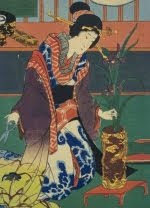Tuesday, 30 November 2010
Facing the Winter Naked
Monday, 29 November 2010
More Water


Friday, 26 November 2010
Ikebana + Bass Performance
Have a look at this video - improvised bass music and ikebana creations in Japanese ceramics. Now that's an innovative and original concept! I love the way the clipping sound from the ikebana scissors becomes part of the music.
Monday, 15 November 2010
Stylized Gestures
One thing that fascinates me about traditional Japanese culture is the thoroughness - the focus on the details. I've been writing in earlier posts about practicing ikebana as a flower ceremony with a set of rules for how to move. It's similar to tea ceremony in the movements and is still practiced by some traditional ikebana schools.
I found this video on YouTube and decided to post it on the blog because of the gestures of the kadoka, the ikebana artist, as she creates a traditional Seika arrangement in what looks like a bamboo vase. The school is Saga Goryu, an ikebana school that goes back to the Emperor Saga in the 9th century and the style of flower arrangement that is said to have been created by him.











